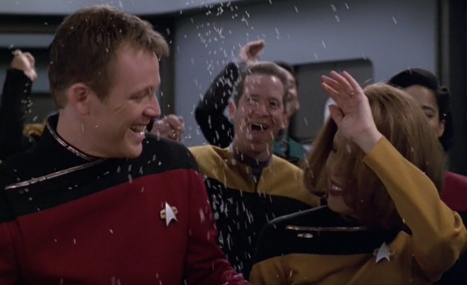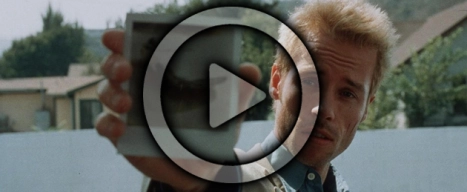Course: Oblivion is a fantastic piece of television, in large part because of how strange and surreal it feels. Like Distant Origin or Living Witness, it is an episode that demonstrates how effective Star Trek: Voyager can be, once it is willing to push itself beyond the template of familiar Star Trek storytelling. Course: Oblivion is a staggeringly weird piece of television, a bottle episode filmed with the primary cast on standing sets, but which only features the briefest of appearances from the regular characters.
More than that, Course: Oblivion effectively weaponises many of the long-standing weaknesses and clichés associated with the storytelling on Voyager. It is the very definition of a “reset” button episode, in that the events (and the ending) of the episode are both catastrophic in scale and utterly inconsequential in the larger scheme of things. In some ways, Course: Oblivion is the quintessential Voyager episode, distilling the destruction of Voyager and the death of Janeway into a tragedy with absolutely no repercussions.

‘Til death do us…
Voyager could often feel generic and disconnected, a show without a unique identity. In many ways, Course: Oblivion is very unique to Voyager in that it builds those core ideas into the very fabric of the episode, constructing an episode that reflects Voyager‘s identity by channeling its identity crisis. As with various other episodes of the fifth season, like Night and Timeless, Course: Oblivion builds a meta-text around the anxieties rippling through Voyager at this point in the run.
However, Course: Oblivion is more than just an effective illustration of Voyager‘s storytelling tropes and unique sensibility. Course: Oblivion is also an episode that taps into a lot of the anxieties bleeding through the zeitgeist at the turn of the millennium. Voyager was undoubtedly a television of its time, and tended to reflect the existential paranoia of the nineties. Course: Oblivion is an episode about what it means to grapple with a person’s own unreality, to wrestle with an existence where meaning no longer exists, and everything is illusory.

“… well, that was quicker than expected.”
Even beyond those themes that anchor Course: Oblivion is the cultural landscape of the late nineties, the episode ties back into broader Star Trek themes. One of the great strengths of the Star Trek franchise is the freedom to use a science-fiction template to explore big questions. Course: Oblivion is an episode about what it means to face death, in a manner very distinct from the way that television usually treats death. The death in Course: Oblivion is not meaningful or epic or heroic. The death in Course: Oblivion is inevitable decay, a murmur in an infinite void.
The result is one of the most striking and effective episodes that Voyager ever produced, and easily the most ambitious episode of the fifth season as a whole.

Face off.
Continue reading →
Filed under: Voyager | Tagged: anxiety, course: oblivion, existential crisis, identity crisis, millennium, reality, unreality, voyager | 8 Comments »





























